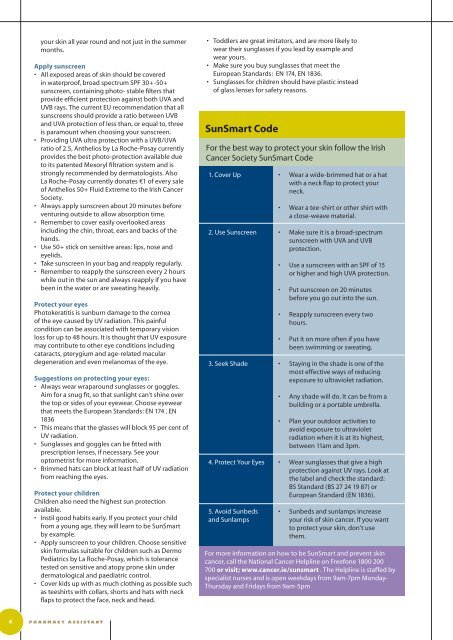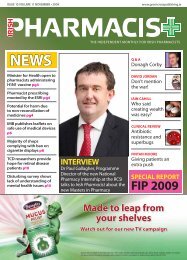Pharmacy Assistant - Green Cross Publishing
Pharmacy Assistant - Green Cross Publishing
Pharmacy Assistant - Green Cross Publishing
You also want an ePaper? Increase the reach of your titles
YUMPU automatically turns print PDFs into web optimized ePapers that Google loves.
4<br />
your skin all year round and not just in the summer<br />
months.<br />
Apply sunscreen<br />
• All exposed areas of skin should be covered<br />
in waterproof, broad spectrum SPF 30+-50+<br />
sunscreen, containing photo- stable filters that<br />
provide efficient protection against both UVA and<br />
UVB rays. The current EU recommendation that all<br />
sunscreens should provide a ratio between UVB<br />
and UVA protection of less than, or equal to, three<br />
is paramount when choosing your sunscreen.<br />
• Providing UVA ultra protection with a UVB/UVA<br />
ratio of 2.5, Anthelios by La Roche-Posay currently<br />
provides the best photo-protection available due<br />
to its patented Mexoryl filtration system and is<br />
strongly recommended by dermatologists. Also<br />
La Roche-Posay currently donates €1 of every sale<br />
of Anthelios 50+ Fluid Extreme to the Irish Cancer<br />
Society.<br />
• Always apply sunscreen about 20 minutes before<br />
venturing outside to allow absorption time.<br />
• Remember to cover easily overlooked areas<br />
including the chin, throat, ears and backs of the<br />
hands.<br />
• Use 50+ stick on sensitive areas: lips, nose and<br />
eyelids.<br />
• Take sunscreen in your bag and reapply regularly.<br />
• Remember to reapply the sunscreen every 2 hours<br />
while out in the sun and always reapply if you have<br />
been in the water or are sweating heavily.<br />
Protect your eyes<br />
Photokeratitis is sunburn damage to the cornea<br />
of the eye caused by UV radiation. This painful<br />
condition can be associated with temporary vision<br />
loss for up to 48 hours. It is thought that UV exposure<br />
may contribute to other eye conditions including<br />
cataracts, pterygium and age-related macular<br />
degeneration and even melanomas of the eye.<br />
Suggestions on protecting your eyes:<br />
• Always wear wraparound sunglasses or goggles.<br />
Aim for a snug fit, so that sunlight can't shine over<br />
the top or sides of your eyewear. Choose eyewear<br />
that meets the European Standards: EN 174 , EN<br />
1836<br />
• This means that the glasses will block 95 per cent of<br />
UV radiation.<br />
• Sunglasses and goggles can be fitted with<br />
prescription lenses, if necessary. See your<br />
optometrist for more information.<br />
• Brimmed hats can block at least half of UV radiation<br />
from reaching the eyes.<br />
Protect your children<br />
Children also need the highest sun protection<br />
available.<br />
• Instil good habits early. If you protect your child<br />
from a young age, they will learn to be SunSmart<br />
by example.<br />
• Apply sunscreen to your children. Choose sensitive<br />
skin formulas suitable for children such as Dermo<br />
Pediatrics by La Roche-Posay, which is tolerance<br />
tested on sensitive and atopy prone skin under<br />
dermatological and paediatric control.<br />
• Cover kids up with as much clothing as possible such<br />
as teeshirts with collars, shorts and hats with neck<br />
flaps to protect the face, neck and head.<br />
pharmacy assistant<br />
• Toddlers are great imitators, and are more likely to<br />
wear their sunglasses if you lead by example and<br />
wear yours.<br />
• Make sure you buy sunglasses that meet the<br />
European Standards: EN 174, EN 1836.<br />
• Sunglasses for children should have plastic instead<br />
of glass lenses for safety reasons.<br />
SunSmart Code<br />
For the best way to protect your skin follow the Irish<br />
Cancer Society SunSmart Code<br />
1. Cover Up<br />
2. Use Sunscreen<br />
3. Seek Shade<br />
4. Protect Your Eyes<br />
5. Avoid Sunbeds<br />
and Sunlamps<br />
• Wear a wide-brimmed hat or a hat<br />
with a neck flap to protect your<br />
neck.<br />
• Wear a tee-shirt or other shirt with<br />
a close-weave material.<br />
• Make sure it is a broad-spectrum<br />
sunscreen with UVA and UVB<br />
protection.<br />
• Use a sunscreen with an SPF of 15<br />
or higher and high UVA protection.<br />
• Put sunscreen on 20 minutes<br />
before you go out into the sun.<br />
• Reapply sunscreen every two<br />
hours.<br />
• Put it on more often if you have<br />
been swimming or sweating.<br />
• Staying in the shade is one of the<br />
most effective ways of reducing<br />
exposure to ultraviolet radiation.<br />
• Any shade will do. It can be from a<br />
building or a portable umbrella.<br />
• Plan your outdoor activities to<br />
avoid exposure to ultraviolet<br />
radiation when it is at its highest,<br />
between 11am and 3pm.<br />
• Wear sunglasses that give a high<br />
protection against UV rays. Look at<br />
the label and check the standard:<br />
BS Standard (BS 27 24 19 87) or<br />
European Standard (EN 1836).<br />
• Sunbeds and sunlamps increase<br />
your risk of skin cancer. If you want<br />
to protect your skin, don’t use<br />
them.<br />
For more information on how to be SunSmart and prevent skin<br />
cancer, call the National Cancer Helpline on Freefone 1800 200<br />
700 or visit; www.cancer.ie/sunsmart . The Helpline is staffed by<br />
specialist nurses and is open weekdays from 9am-7pm Monday-<br />
Thursday and Fridays from 9am-5pm










